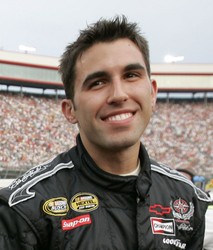Ask a pro
Receive advice directly from today’s top stars


Aric Almirola
NASCAR Sprint Cup driver for Richard Petty Motorsports
NASCAR ace Aric Almirola is the latest online driving instructor for SAFEisFAST.com.
The Florida-born stock car driver currently competes for Richard Petty Motorsports in the NASCAR Sprint Cup Series, and has made over 330 starts across North America’s premier motorsport discipline. Almirola took to Victory Lane during the 2014 Coke Zero 400 at the iconic Daytona Speedway, and remains one of the series’ frontrunners to this day.
Aric Almirola answers your questions!
-
Bob
How much of your time is spent with sponsor activities as opposed to driving and testing? Do you think it’s important for a young driver to work on PR skills? How do you practice?




I probably have an equal amount of time with sponsors and PR as I do actually driving the race car, and that is very important to be not only a good race car driver but also a good spokesman, because you’re representing more than yourself nowadays. With a big corporate sponsor like Smithfield Foods and a big manufacturer like Ford Motor Company you’re representing thousands, if not millions, of people, so it’s important to carry yourself properly and represent the people that have invested a lot of money in you so that they continue to do it and that they benefit from it.
SAFEisFAST.com videos: Sponsorship Overview, Working with the Media 2
-
Simon
I’m just starting in karting racing and the toughest thing for me seems to be keeping my concentration going for the entire race, and our races are short. How do you do it for three or four hours? Any tricks you can suggest?




I stay pretty focused in the race car. The thing that keeps me the most focused is always trying to run a better lap the next lap, and so I’m always concentrated and focused on doing that. One of the things that I do to stay focused for three or four hours in the race car is that I challenge myself at every single corner on every single lap to make that corner or lap the best of the race. It doesn’t matter if it’s lap 5 of the race or lap 155, I’m trying to constantly perfect corners and that challenges myself and my brain to stay focused.
SAFEisFAST.com video: Focus and Concentration
-
Erik
Just watched the video on driving a stock car on a road course. How tough was it as an oval racer to adapt to driving on a road course? What did you have to do differently?




The most challenging part of going from oval racing to road course racing is maximizing the braking zones. In oval racing the way you brake for the corners is drastically different; you use a little bit of brake pressure, because most oval racing is about using as little brake as you can, while road course racing is about using as much brake as you possibly can in a short amount of time.
SAFEisFAST.com videos: Braking, Hustling a Stock Car around a Road Course
-
nascarfan85
What is your favourite oval track and why?




Dover International Raceway. It’s a very unique race track as it’s just one mile long, has high banking and a concrete surface. The sensation of speed is unlike any other track we go to and it’s very challenging to drive. It has the nickname the ‘Monster Mile’, which coincides with just how hard it is to get around.
-
Tim
Are there any other types of motorsport that you want to try before you retire? I always find it interesting how IndyCar drivers move to NASCAR but not the other way round so much. Thanks




As far as racing on circuits for points and things like that, I’m fully content to race in NASCAR, because when my career is over I can call it a good one, but I would love the chance to drive a Formula 1 car. One at least, but more would be great! I’d also like to drive a winged sprint car on dirt once if not more, but I have no desire to race in any other championship competitively than the ones I am currently doing.
I think money is the reason we see more IndyCar drivers coming over to NASCAR than the other way round. There’s a lot more money to be made in NASCAR, especially if you’re successful, than in IndyCar. -
Ricky
How much guidance have you been given from The King? It must be amazing having him as a boss!




There are certain things that he can guide me on away from the track, but as far as the stuff on the race track is concerned there’s so many things that have changed since he was racing in the ‘60s and ‘70s. A lot that he did and knows is irrelevant now, but yes it is amazing to have him as a boss!
-
Lucy
Obviously a big part of oval racing is picking a line and holding it. Do you have a general preference to high or low? Or is it determined just by car setup?




I honestly don’t have a preference. It’s usually race track driven, but I do enjoy running the high line up against the fence at some of the race tracks we go to, but the track itself often determines what race line we’re going to run, as well as the car setup too.
SAFEisFAST video: The Fast Line
-
Michael Martin
Since oval track racing is the norm of NASCAR this is a perfect question to ask you. What are some challenges of driving a stock car on Ovals?




The biggest challenge of driving a stock car on an oval is that the car weighs 3400lbs and we run 10-inch slick tires, so the cars slide around a lot. Even the best car in the race is not capable of running wide open at the tracks we go to, besides Talladega and Daytona with restrictor plates. The race cars are heavy and the centre of gravity is high, so the downforce is low and they slide around a lot. That’s why you see a lot of the guys from other series who come to NASCAR, whether it’s from F1 or IndyCar, have such a hard time being successful.
SAFEisFAST.com video: Oval Racing
-
Steve
Hi Aric. I’ve always been puzzled when people/other drivers talk about “higher banking equals less brake.” I’m a road racer looking to get into short track oval racing and always wondered if that means they use a wider line (more of a single apex vs. A diamond/double apex) or use an arc based upon the corner radius and use the amount of brake based upon the banking angle?




Higher banking allows the car to stick to the race track better, so if the car sticks to the race track better you have to slow down less for the corner and you get to use less brake. In my opinion banking has never had a big effect on the apex of the corner or the arc, but the radius of the corner has a big effect. In oval racing you always try and get the biggest arc going into the corner.
-
Jason
Do you think you could turn the season around from here?




Yeah I do Jason! I think we’ve got a lot of high quality people at Richard Petty Motorsport who are very smart. The challenge at the start of this year was getting more speed in our cars, but I’m confident now that we can get the season turned around. I think one of our most important goals is getting back to the competitive level that we were at last year when on every weekend we were confident that our cars were fast enough to run in the top 15. This year we’ve not been able to do that.
-
crushcastles23
What is your biggest regret stemming from racing?




I honestly don’t have any regrets as far as racing goes. There’s some races that I wish I could have back and the opportunities along the way that I may have missed, but I feel very fortunate to be where I’m at today, and along the way a lot of things that have happened to have got me here, so I feel very appreciative, very lucky and very blessed, and I wouldn’t change any of it.
-
Justin Stelzer
With the NASCAR schedule not going through many year to year changes, has it made it easier for the teams to adapt old car setups from previous seasons, or have the changes made to the design of the car been enough to offset that?




No. The design of the car is changing so much and the evolution of setups is happening so fast on our race cars that old setups are exactly that. It’s very difficult to run an old setup at a race track you ran last year and be competitive with it.
SAFEisFAST.com video: Engineering the Race Car
-
Jim
Aric, first of all you have a lot of talent as a driver. Any hope that RPM will give you what you need to win races any time soon? You deserve better than this.




Well thank you Jim, I appreciate the support and I can confirm that as a team we’re really working hard on it.
-
Thomas
Hi Aric. Well done on your win at Daytona, it was well deserved! What I want to know is how different does a Sprint Cup car feel to drive compared to an Xfinity car?




Sprint Cup cars feel much more different than an Xfinity car. An Xfinity car typically has much more downforce and much more drag, and a Sprint Cup on the contrary has less downforce and less drag, and is much faster on corner entry.
I like driving both and like the challenges each provides, but I love driving the Sprint Cup car. As a race car driver, adapting between cars well is what separates the good drivers from the average ones.SAFEisFAST video: The Complete Driver
-
Rashid
It must be great to be a professional race driver but what is the worst part about your job?




The worst part about my job is the enormous amount of time I spend travelling on the road. A lot of it is without my family with me, so I end up spending a lot of time away from my wife and my two little kids. So that’s challenging sometimes.
-
Andy
NASCAR seems quite simple, so I imagine they are quite easy to set up too. With that in mind, can you tell me why certain teams are always at the front of the grid and others at the back? Surely it should be more mixed with such similar cars?




NASCAR is very deceiving. It may look simple and the cars look all the same, but with the rule packages being so tight it ends up becoming more challenging for teams to find advantages. Because of that, a really powerful and successful team might find 100 little advantages, whereas the smaller teams with little resource might find 10, so you end up getting outrun by those 90 small advantages that you don’t have. When the rules are more open everybody can find one or two big advantages, and that levels the playing field to a certain extent.
-
James
Hello Aric, I’m a young driver looking to make it into car racing after a few years of racing near the front in kart racing. I’m struggling with finding sponsors though. Have you got any tips? Thanks!




Welcome to racing! Probably the number one lesson that I had to learn was that it doesn’t matter how good of a race car driver you are – without proper funding it’s very hard to continue and to move up any of the levels. You really have to have the proper funding and in this sport it takes a lot of it to go fast. Having a sponsor that believes in you, and a quality sponsor in the sport is extremely important, and you have to do everything you can to sell yourself and figure out ways to show companies that not only you are the right person to help build the brand of their company but also that the sport is the right sport to be in.
SAFEisFAST.com video: Sponsorship Overview
-
Dominic O’Connell
NASCAR has gone through a number of changes since you joined the sport, but from a driver’s point of view, what’s changed most about how the car drives?




That’s a tough one because in all the years I’ve been in NASCAR since 2005, everything has changed so much. We went from having cars that were really hard to drive to when the COT (Car of Tomorrow) came out, cars that were very easy to drive. Now they’re starting to take more and more downforce off the cars again which is making them harder to drive. So over the years I think there’s been such a wide range of changes to the car that I can’t pinpoint one thing that’s made the cars different to drive. It all revolves around downforce; the more downforce we have the easier they are to drive, whereas the less downforce we have the harder they become to drive.
I’m a very big fan of less downforce because I feel it puts more tools in a driver’s toolbox so to speak. When you have a lot of downforce the driver can practically hold the car wide open, and you’re very reliant on the car the team gives you, because if you hold it wide open it doesn’t matter who’s driving the car. When everybody has to let off the gas and get on the brakes to make it around the race track, or if the car doesn’t stick to the race track because of reduced downforce, it gives the driver inside the cockpit more options.
SAFEisFAST video: Driving with Downforce
-
Doug B.
Hello Aric, thanks for taking the time to answer questions. You really worked your way up the traditional, hard way. You started in karts and then ran in just about every stock car series you could on the way up to Cup racing. Is this the best way, or in hindsight would you suggest a different route? Some other Cup drivers have come from sprint cars and midgets.




I honestly think you can come from any form of racing, just as long as you start at an early enough age to gain enough experience and learn the proper driving habits that you need to continue growing and developing along the way.
SAFEisFAST.com Video: The Ladder System
-
Peter
Watching on TV, driving a stock car doesn’t look that tough physically, but I’m sure it is. How tough is it really? What do you do off-the-track to train for it? Is it mostly endurance, or do you also work on strength?




To a certain degree it is challenging. You don’t have to be a bodybuilder to do it though, or a marathon runner, or a triathlete, but for sure you need to have some physical endurance. I workout two or three times a week at the gym and I also try to put in as many miles a week as I can on my bicycle – I do quite a bit of cycling when time allows for it. The biggest muscle group to work on in my opinion, to drive any race car, is the core. Whether you’re road course racing or oval racing, the g-forces are always trying to take your body in the opposite direction the car is heading, and you’re body revolves around your core. Basically if you have a strong core you can stay upright.
SAFEisFAST.com video: Fitness Overview
 Road Racing Drivers Club
Road Racing Drivers Club
 Share
Share







